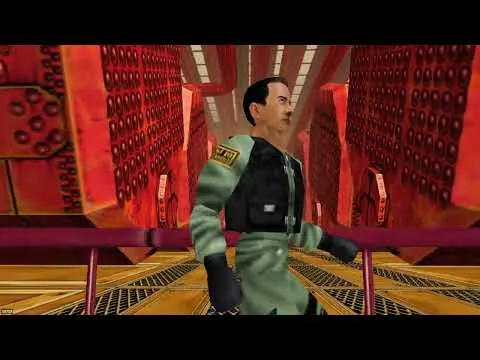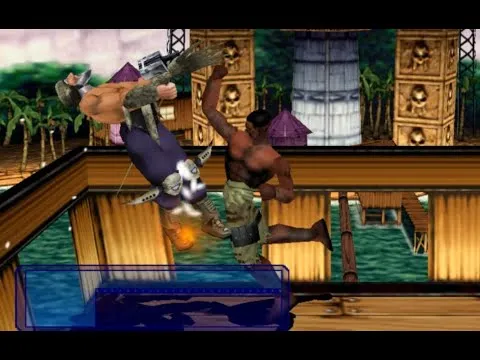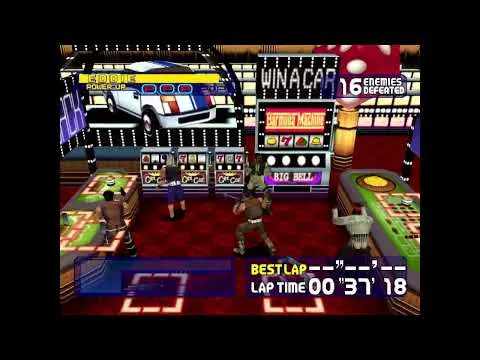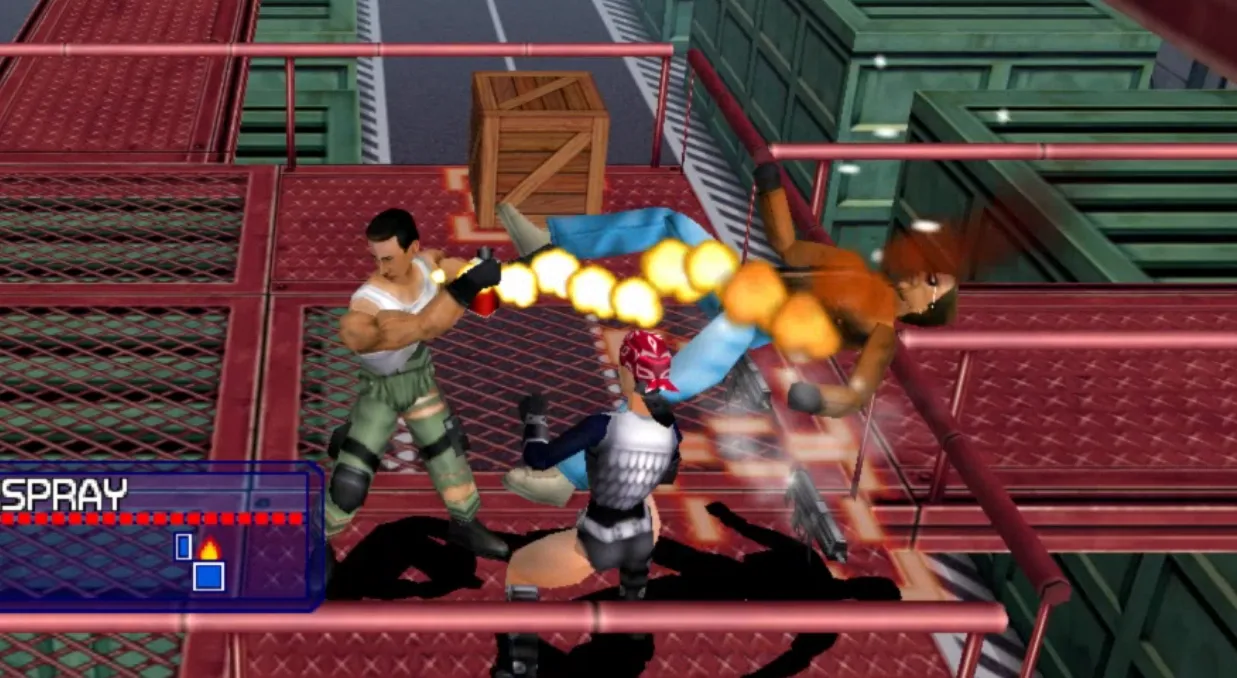

If you remember when I talked about Die Hard Arcade, you may remember that at the end of everything I off-handedly mentioned the one sequel it got not having any connection to the Die Hard name.
The original Dynamite Deka, at least according to the sources here, was strongly inspired by Die Hard but wasn't actually granted the license for the international versions until late into development - which is why it wasn't there in the Japanese version. At the end of the day, the fact the game was just "inspired" by Die Hard in Japan is what allowed it to have a second game, Dynamite Deka 2, and would release overseas as Dynamite Cop - connected to the first game but officially unrelated to Die Hard.
But enough talk of that whole debacle - it's time to talk about what this sequel actually puts in the table to improve over the previous title.
More movement, more explosions

If you had played Die Hard Arcade before, you'll instantly notice here that your character can actually move and attack in all directions in 3D, instead of moving around as if you were in a 2D sidescroller [which complicated a few moments in DHA], so it can feel smoother in that sense right from the get go. And yes, the quick time events return here, although the game doesn't show you anymore the enemy healthbars nor whenever you have excess of health in your lifebar.
On top of the usual Punch/Kick/Jump buttons, as well as the mandatory search-them-yourself extra moves, by pressing all three buttons [or the Escape button in the home ports if you have it configured] you can use a get-off-me circular attack, an usual staple from beat-em-ups [including SEGA's own Streets of Rage and Spikeout games] that was notably absent in DHA.
If you are being held by a big enemy or boss, this can be useful to get them off for a smaller amount of health reduced from hitting any enemy with it [similar to SOR]. You can also now run if you double tap the directions - the controller I was using was kind of struggling with that for some reason [drifty joystick] but when I tried on Keyboard it was easier to get more consistently, so THAT is going to be very useful for your own journey if you try it out.
Additionally, while a lot of the crazy weapons return, from the expected yet unusually lethal suspects [Guns, axes, anti-tank rifles and rocket launcher] to the sillier choices [Cake slices, coins from a bucket, pepper spray and even the hairspray + lighter combo], the biggest shakeup Dynamite Cop provides is the Power Up system.
If you pick up five P items [or one S item], you will enter a powered up state where your basic combos will be longer, and this extends to the amount of attacks you do in your throws and even while holding most weapons [including the handgun - leading to you doing some super stylish one-handed followups]. It is a treat to use, more so if there's an S item to instantly refill your power bar even if you already have it active - which doesn't happen with the P items.
A mostly smoother ride, but don't let your guard down still
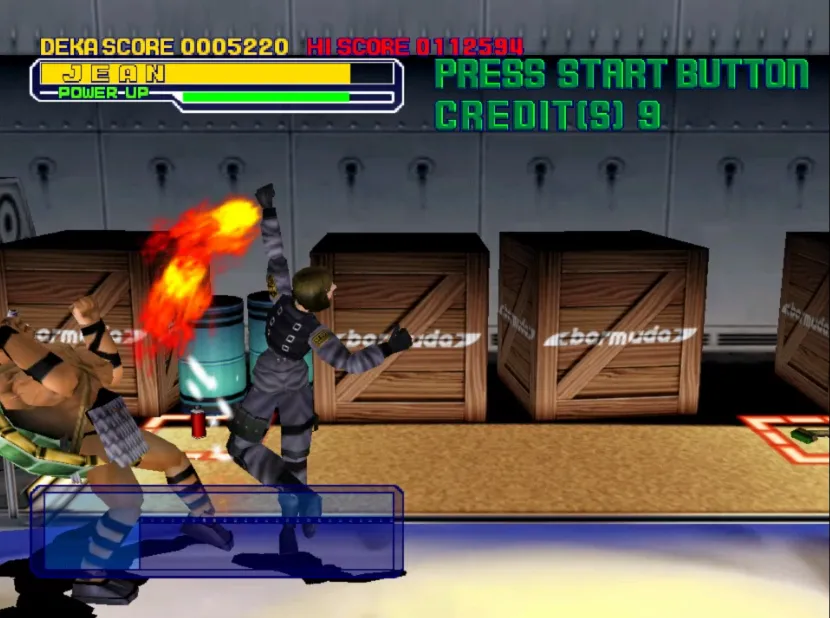
The improved movement and power up buffs mean that you can consistently dish out a bit more damage than before, and more so when the AI sometimes can be slightly less vicious if they are trying to navigate around obstacles - but don't let your guard down.
Enemies with weapons can still take a sizable chunk of your health if you let them do so, whether its the dual sword users attacking you or even getting you into a grab only escapable with the Escape attack, or the dual machinegun users which can pump you with lead whether standing or even sometimes when lying on the floor after a knockdown.
Wolf Hongo, the guy you defeat at the first game, actually returns with a modified cybernetic body...and the fact he was there is what made me realize that the game was also shorter than I expected on a single playthrough. But even with your improved moves and his loss of knives, he still has some nasty combos, surprise cannons and even a teleport into a machinegun attack to easily tear your health down in seconds.
But the thing is that even with those things in mind...it was noticeably a somewhat easier experience than Die Hard Arcade.
While my first completion in DHA took me 16 whopping credits that I had to farm off the included minigame in the Saturn version [as it only gave you 5 by default], to my surprise, I only had to continue 5 times in the arcade version of Dynamite Cop - which was the first version I tried tonight. Then I decided to try again in the Dreamcast port...and turns out I also ended up with 5 continues used because Wolf Hongo is STILL a pain to deal with.
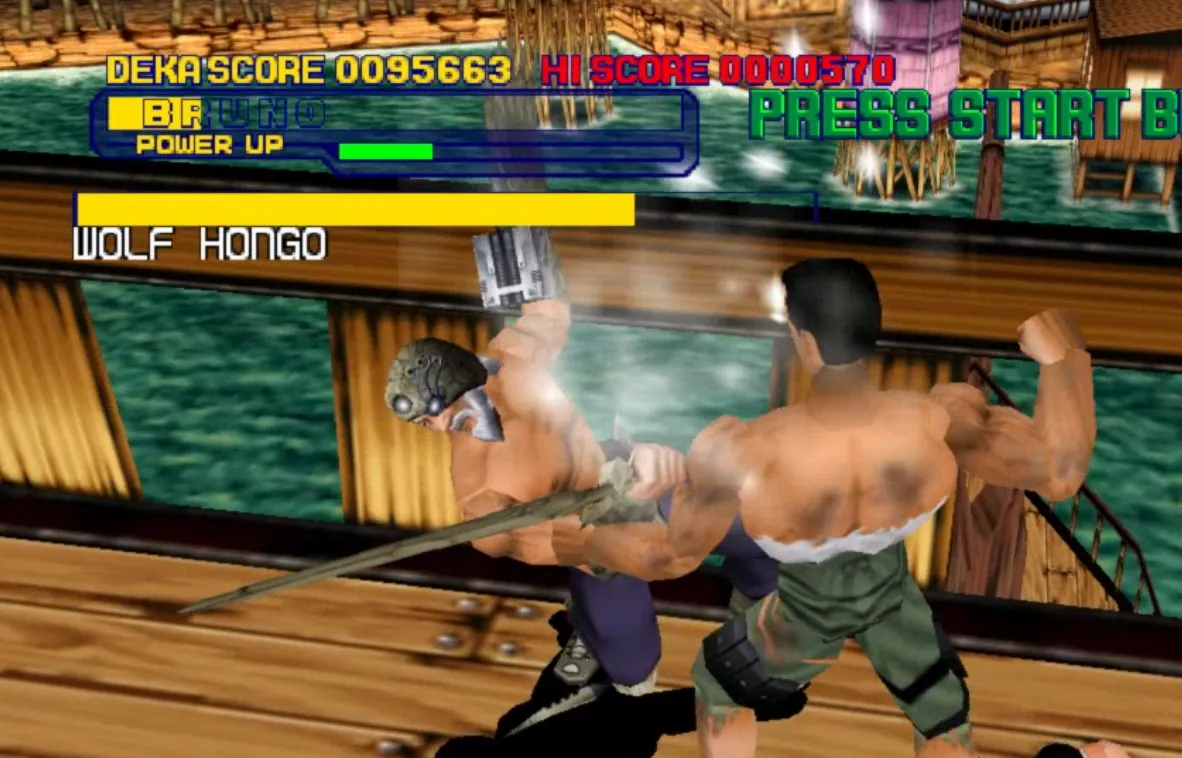
Putting aside the final boss being kinda cheap if you can't avoid his bullets [which is easy to fail if you can't jump into the middle platform and jump right as he shoots] as well as don't get a Power Up right before fighting him, it is comparatively much less of a long haul to survive than DHA with limited credits - and Mission 1 in the Dreamcast port has infinite credits.
While Mission 2 has 10 credits and Misison 3 has 5, the end of Mission 2 is actually a bit tougher because you get to see a different set of stages near the end rather than the island at Mission 1...which results in you fighting Hongo at a wide but platformless stage, forcing you to rely on your running.
Misison 3 however, while has some areas remixed and rearranged, does end with the same final set of stages at the Island with a few differences. But at least the way you enter the boat where the game takes place and some cutscenes [mainly in Missoin 2] are different enough to give it some variety rather than feeling like a textbook repeat of Mission 1.
I even happened to get to Wolf Hongo in Mission 3 with Eddie and gave him half a whopping thanks to an S-Item appearing right before the fight. I was CLOSE to beating him with only one continue instead of two but then I choked the second one - thankfully still being enough to finish Mission 3 because I had played better than before.
This was likely not only because I had been playing beforehand the Survival mode a few timeswhich already forces you to strategize with large crowds, but also because Eddie seems to be faster in a few ways, from the PPPPK combo's speed to even how you can do PPPK too with him but not Bruno - meaning you can do faster knockdowns which can be important to multitask with enemies.
...yeah, I said Survival mode. Thankfully unlike Die Hard Arcade, this one has a few extras to have more fun with.
The Dreamcast bonuses
While this game is unfortunately stuck in the Dreamcast with no modern re-releases, at least said DC port has a few extras to the game - even if they aren't PLENTY it's still some more than what Die Hard Arcade provided on the SEGA Saturn.
One bonus that is similar to DHA's port is the existence of an old SEGA game as a bonus feature. Unlike DHA where it is kind of important because it is the only way to get more credits there, here not only it doesn't give you more credits for the main game...but also needs to be unlocked by beating the game once.

At least it is a more interactive game, even if definitely harder due to that - you basically walk around this tiny maze shooting tranquilizers at animals and carrying them to your car...or something like that. But obviously, you can easily get bumrushed by the lions and elephants you are trying to catch if enough time has passed.
Survival Mode is about enduring waves of enemies in a single room...and it is harder than you think even with the extra benefits of Dynamite Cop.
For example, in the first mission/room, you have to fight against 30 enemies total, but two have dual swords, then two have dual machineguns, and then eventually you face off against the first two bosses of the game. And of course, you gotta deal with all of them with one healthbar - no health pickups spawned.
It took me several attempts trying with Bruno until I switched to Eddie and then kept trying some more until I managed to pull off a clean survival of most enemies until the two bosses, and narrowly avoided death - getting my prize. Too bad that Mission 2 and 3 apparently are bumped to a whopping 60 and 100 enemies...so that will be even more difficult - more so if they don't drop health pickups in those.
And finally, there's...a Versus mode.
I would go more in-depth with it if I had anyone to try it right now, but I don't, so I will leave it as a little cool bonus to see that you can casually fight another player with the game's controls being as neat as they are now.
Conclusion
If you aren't patient, then this game can still kick your ass handily, even if not as brutally as Die Hard Arcade, but if you got the guts, then you will have a far easier time here.
That is, unless you are also going for Showdown mode's extra missions unlocked after beating the first three - they are harder variants of the first tree, but according to this FAQ...
Mission 4 is based on Mission 1 with a single life, double damage weapons, and no continues.
Mission 5 is based on Mission 2 with a time limit in each room and no continues.
Mission 6 is based on mission 3, with very little health, few health power-ups, no other power-ups, and no continues.
...Which means that this game somehow had a way to give you the middle finger Die Hard style with these challenges - as obviously, trying to go through each mission without continuing IS hard with how you have to keep a single bar of health and a lot of enemies at bay for that, let alone with additional conditions that will make everything even harder.
Even Mission 6 seems to be only for the toughest of veterans when the game starts with you having NO HEALTH...so you gotta survive for most of the game slowly refilling your health while avoiding getting hit AT ALL at the beginning stages.
But putting THAT amount of unusually exaggerated extra torture aside in the form of an extra mode, I definitely recommend this game as being way more accessible than Die Hard Arcade.
Before I go though, here's two goofy cutscenes that I found pretty amusing.
First one, this guy that you fight before the final boss, which you actually see as an ally captain in the intro of Mission 2 and 3...but here he just appears tied - until turns out that he's a fake masquerading as him [in ALL missions he does this, but in Mission 1 there's no context for him]. And the hilarious thing isn't the delivery of the line, but your reaction every time.
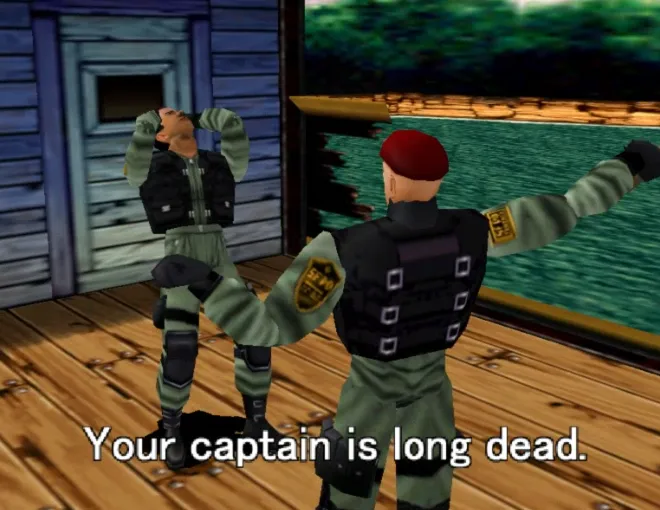
...Which is only made better by how in Mission 1 and 3 [but not 2 for some reason] you can just start caving his face in while he's speaking.
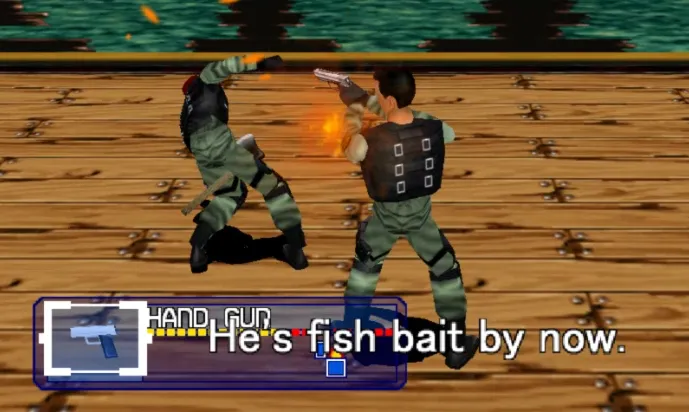
Then there's this one, Mission 1's ending, whether you accidentally push off a laptop detonating the island, with your buddies and even the president's daughter you just rescued being in disbelief at your goof.
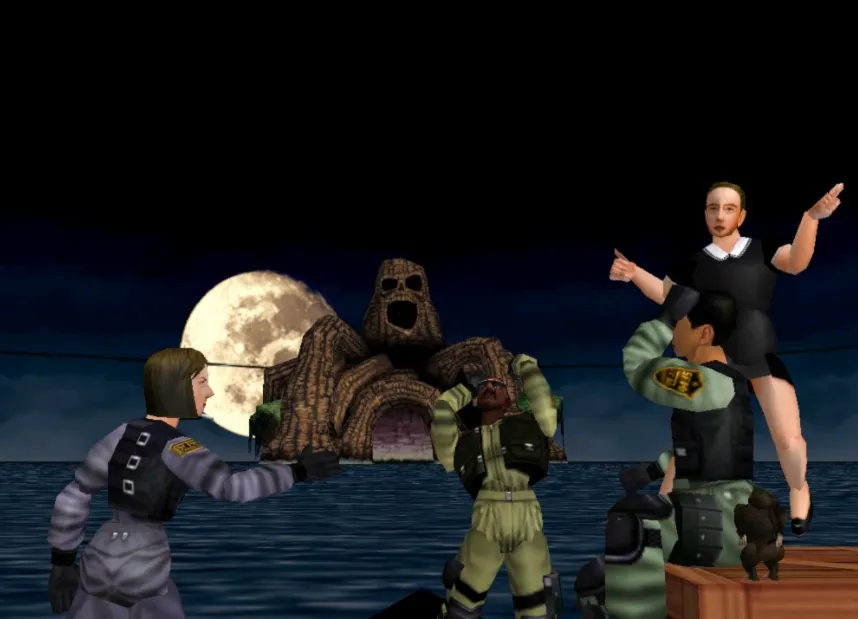
And I would tell you about Mission 2's ending, but it is one that only makes sense if you go watch it rather than see me describe in screenshots because of how fast things go in it.
Anyways, that's all for today, definitely played this one today WAY more than I was initially planning to, so I call that a good sign on my book for the game having some fun factor to make it instantly replayable or at least easily revisitable later.
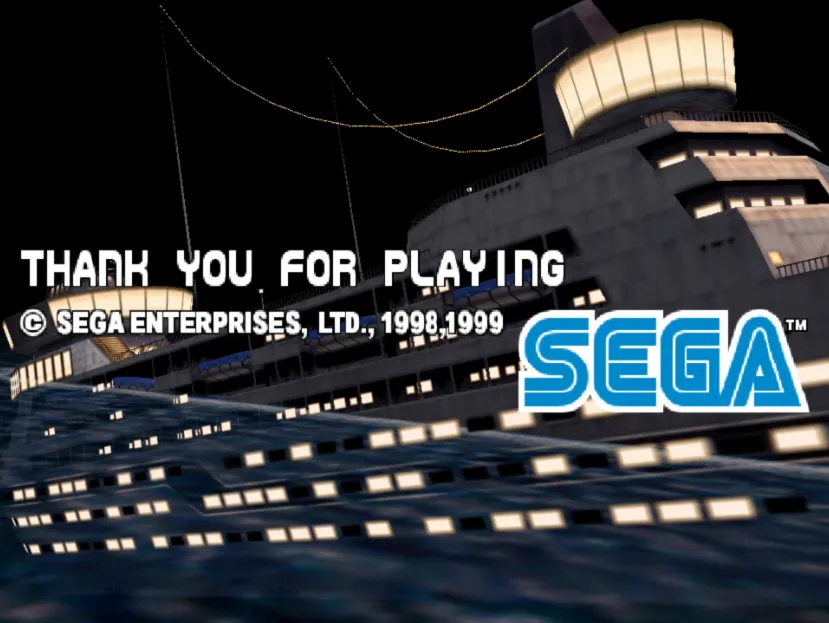
Thanks for reading!

Spanish translation with DeepL. All screenshots were captured by myself.
Español
Si recuerdas cuando hablé de Die Hard Arcade, puede que recuerdes que al final de todo mencioné de pasada que la única secuela que tuvo no tenía ninguna conexión con el nombre de Die Hard.
El Dynamite Deka original, al menos según las fuentes de aquí, estaba fuertemente inspirado en Die Hard/Duro de Matar, pero no se le concedió la licencia para las versiones internacionales hasta bien avanzado el desarrollo, razón por la cual no aparecía en la versión japonesa. Al fin y al cabo, el hecho de que el juego se «inspirara» en Duro de Matar en Japón es lo que le permitió tener un segundo juego, Dynamite Deka 2, y salir a la venta en el extranjero como Dynamite Cop, relacionado con el primero pero oficialmente sin relación con Duro de Matar.
Pero basta de hablar de toda esa debacle: es hora de hablar de lo que esta secuela realmente pone sobre la mesa para mejorar respecto al título anterior.
Más movimiento, más explosiones

Si ya habías jugado a Die Hard Arcade, aquí te darás cuenta al instante de que tu personaje puede moverse y atacar en todas direcciones en 3D, en lugar de desplazarse como si estuvieras en un sidescroller 2D [lo que complicaba algunos momentos en DHA], por lo que puede parecer más fluido en ese sentido desde el primer momento. Y sí, aquí vuelven los quick time events, aunque el juego ya no te muestra las barras de salud enemigas ni cuando te sobra salud en tu barra de vida.
Además de los botones habituales de Puñetazo/Patada/Salto, así como los obligatorios movimientos extra de búsqueda, pulsando los tres botones [o el botón Escape en los puertos de inicio si lo tienes configurado] puedes usar un ataque circular para salir de mí, un elemento básico habitual de los beat-em-ups [incluidos los propios juegos Streets of Rage y Spikeout de SEGA] que estaba notablemente ausente en DHA.
Si te retiene un enemigo grande o un jefe, esto puede ser útil para quitártelo de encima por una cantidad menor de salud reducida al golpear a cualquier enemigo con él [similar a SOR]. Ahora también puedes correr si tocas dos veces las direcciones - el mando que estaba usando tenía problemas con eso por alguna razón [joystick a la deriva] pero cuando lo probé en Keyboard fue más fácil conseguirlo de forma más consistente, así que ESO va a ser muy útil para tu propio viaje si lo pruebas.
Además, aunque muchas de las armas locas vuelven, desde las esperadas pero inusualmente letales sospechosas [pistolas, hachas, rifles antitanque y lanzacohetes] hasta las opciones más tontas [trozos de tarta, monedas de un cubo, spray de pimienta e incluso el combo de laca para el pelo + mechero], la mayor novedad que ofrece Dynamite Cop es el sistema de potenciadores.
Si recoges cinco objetos P [o un objeto S], entrarás en un estado de potenciación en el que tus combos básicos serán más largos, y esto se extiende a la cantidad de ataques que haces en tus lanzamientos e incluso mientras empuñas la mayoría de las armas [incluida la pistola - lo que te lleva a hacer algunos seguimientos súper elegantes con una sola mano]. Es una delicia usarlo, más aún si hay un objeto S para rellenar instantáneamente tu barra de energía aunque ya la tengas activa - lo que no ocurre con los objetos P.
Un viaje más suave, pero no bajes la guardia.

Las mejoras en el movimiento y en los potenciadores significan que puedes infligir más daño que antes, y más cuando la IA a veces puede ser un poco menos feroz si está intentando sortear obstáculos, pero no bajes la guardia.
Los enemigos armados aún pueden quitarte una buena parte de tu salud si se lo permites, ya sean los usuarios de espadas duales que te atacan o que incluso te agarran y de los que sólo puedes escapar con el ataque Escape, o los usuarios de ametralladoras duales que pueden bombardearte con plomo tanto si estás de pie como si estás tumbado en el suelo tras un derribo.
Wolf Hongo, el tipo al que derrotas en la primera partida, vuelve con un cuerpo cibernético modificado... y el hecho de que estuviera ahí es lo que me hizo darme cuenta de que el juego también era más corto de lo que esperaba en una sola partida. Pero incluso con tus movimientos mejorados y su pérdida de cuchillos, sigue teniendo algunos combos desagradables, cañones sorpresa e incluso un teletransporte a un ataque de ametralladora para destrozarte fácilmente la salud en cuestión de segundos.
Pero el caso es que incluso teniendo en cuenta estas cosas... la experiencia fue notablemente más fácil que Die Hard Arcade.
Mientras que la primera vez que completé DHA me costó la friolera de 16 créditos que tuve que conseguir en el minijuego incluido en la versión de Saturn [ya que sólo te daba 5 por defecto], para mi sorpresa, sólo tuve que continuar 5 veces en la versión arcade de Dynamite Cop, que fue la primera versión que probé esta noche. Luego decidí volver a intentarlo en la versión de Dreamcast... y resulta que también acabé con 5 continuaciones usadas porque Wolf Hongo sigue siendo un coñazo.

Dejando a un lado que el jefe final es un poco barato si no puedes evitar sus balas [lo cual es fácil de fallar si no puedes saltar a la plataforma central y saltar justo cuando dispara] y si no consigues un Power Up justo antes de luchar contra él, es comparativamente mucho menos largo sobrevivir que DHA con créditos limitados - y la Misión 1 en el port de Dreamcast tiene créditos infinitos.
Mientras que la Misión 2 tiene 10 créditos y Misison 3 tiene 5, el final de la Misión 2 es en realidad un poco más duro porque llegas a ver un conjunto diferente de escenarios cerca del final en lugar de la isla en la Misión 1... lo que hace que luches contra Hongo en un escenario amplio pero sin plataformas, obligándote a confiar en tu forma de correr.
Misison 3, sin embargo, aunque tiene algunas zonas remezcladas y reorganizadas, termina con el mismo conjunto final de fases en la isla, con algunas diferencias. Pero al menos la forma de entrar en el barco en el que se desarrolla el juego y algunas escenas [sobre todo en Missoin 2] son lo bastante diferentes como para darle algo de variedad en lugar de parecer una repetición de libro de texto de la Misión 1.
Incluso llegué a enfrentarme a Wolf Hongo en la misión 3 con Eddie y le di media paliza gracias a un objeto S que apareció justo antes del combate. Estuve CERCA de derrotarle con una sola continuación en lugar de dos, pero entonces se me atragantó la segunda -afortunadamente aún así fue suficiente para terminar la Misión 3 porque había jugado mejor que antes.
Esto se debió no sólo a que había jugado antes al modo Supervivencia unas cuantas veces, que ya te obliga a crear estrategias con grandes multitudes, sino también a que Eddie parece ser más rápido en algunos aspectos, desde la velocidad del combo PPPPK hasta cómo puedes hacer PPPK también con él pero no con Bruno, lo que significa que puedes hacer derribos más rápidos, lo que puede ser importante para hacer varias cosas a la vez con los enemigos.
...sí, he dicho modo Supervivencia. Afortunadamente, a diferencia de Die Hard Arcade, este tiene algunos extras con los que divertirse más.
Las bonificaciones de Dreamcast
Aunque por desgracia este juego está atascado en la Dreamcast sin reediciones modernas, al menos dicho port de DC tiene unos cuantos extras para el juego - incluso si no son PLANTY sigue siendo algo más de lo que Die Hard Arcade ofrecía en la SEGA Saturn.
Un extra que es similar al port de DHA es la existencia de un antiguo juego de SEGA como extra. A diferencia de DHA, donde es importante porque es la única forma de conseguir más créditos, aquí no sólo no te da más créditos para el juego principal, sino que además hay que desbloquearlo superando el juego una vez.

Al menos es un juego más interactivo, aunque definitivamente más difícil debido a eso - básicamente caminas por este pequeño laberinto disparando tranquilizantes a los animales y llevándolos a tu coche... o algo así. Pero, obviamente, es fácil que los leones y elefantes que intentas cazar te acorralen si ha pasado suficiente tiempo.
El modo Supervivencia consiste en aguantar oleadas de enemigos en una sola habitación... y es más difícil de lo que crees incluso con las ventajas extra de Dynamite Cop.
Por ejemplo, en la primera misión/habitación, tienes que luchar contra 30 enemigos en total, pero dos tienen espadas duales, luego dos tienen ametralladoras duales, y finalmente te enfrentas a los dos primeros jefes del juego. Y, por supuesto, tienes que enfrentarte a todos ellos con una sola barra de salud.
Me costó varios intentos con Bruno hasta que cambié a Eddie y seguí intentándolo hasta que conseguí sobrevivir a la mayoría de los enemigos hasta los dos jefes y evitar la muerte por los pelos, consiguiendo mi premio. Lástima que, al parecer, las misiones 2 y 3 tengan la friolera de 60 y 100 enemigos... así que serán aún más difíciles, y más si en ellas no dejan recoger salud.
Y por último, hay... un modo Versus.
Profundizaría más en él si tuviera a alguien para probarlo ahora mismo, pero no lo tengo, así que lo dejaré como un pequeño bonus molón para ver que se puede luchar casualmente contra otro jugador siendo los controles del juego tan pulcros como son ahora.
Conclusión
Si no tienes paciencia, este juego puede patearte el culo, aunque no tan brutalmente como Die Hard Arcade, pero si tienes agallas, lo tendrás mucho más fácil.
Es decir, a menos que también vayas a por las misiones extra del modo Showdown que se desbloquean tras superar las tres primeras: son variantes más difíciles del primer árbol, pero según este FAQ...
La misión 4 está basada en la misión 1 con una sola vida, armas de doble daño y sin continuaciones.
La misión 5 está basada en la misión 2 con un límite de tiempo en cada sala y sin continuaciones.
La misión 6 está basada en la misión 3, con muy poca salud, pocos potenciadores de salud, ningún otro potenciador y sin continuaciones.
...Lo que significa que este juego de alguna manera tenía una forma de darte el dedo medio al estilo Duro de Matar con estos desafíos - ya que obviamente, intentar pasar cada misión sin continuar ES difícil con lo que tienes que mantener una sola barra de salud y un montón de enemigos a raya para ello, sin hablar de las condiciones adicionales que harán que todo sea aún más difícil.
Incluso la misión 6 parece ser sólo para los veteranos más duros, ya que el juego empieza sin que tengas NADA DE SALUD... así que tienes que sobrevivir durante la mayor parte del juego recargando lentamente tu salud mientras evitas que te golpeen en absoluto al principio.
Pero dejando a un lado ESA cantidad de tortura extra inusualmente exagerada en forma de modo extra, definitivamente recomiendo este juego por ser mucho más accesible que Die Hard Arcade.
Antes de irme, aquí hay dos escenas tontas que me parecieron muy divertidas.
En primer lugar, el tipo contra el que luchas antes del jefe final, que en realidad aparece como capitán aliado en la introducción de las misiones 2 y 3... pero aquí simplemente aparece atado, hasta que resulta que es un impostor que se hace pasar por él [en TODAS las misiones hace esto, pero en la misión 1 no hay contexto para él]. Y lo hilarante no es la entrega de la línea, pero su reacción cada vez.

...Lo cual es aún mejor porque en las misiones 1 y 3 [pero no en la 2 por alguna razón] puedes empezar a partirle la cara mientras habla.

Y luego está el final de la misión 1, en el que accidentalmente empujas un portátil detonando la isla, con tus compañeros e incluso la hija del presidente a la que acabas de rescatar mostrándose incrédulos ante tu metedura de pata.

Y te contaría el final de la Misión 2, pero solo tiene sentido si lo ves en lugar de que te lo describa en capturas de pantalla, por lo rápido que van las cosas.
De todos modos, eso es todo por hoy, definitivamente jugado este hoy MUCHO más de lo que inicialmente estaba planeando, así que yo llamo a que una buena señal en mi libro para el juego que tiene algún factor de diversión para que sea instantáneamente rejugable o al menos fácilmente revisitable más tarde.

¡Gracias por leer!

Traducción al español hecha con DeepL. Todas las fotos capturadas por mí.
